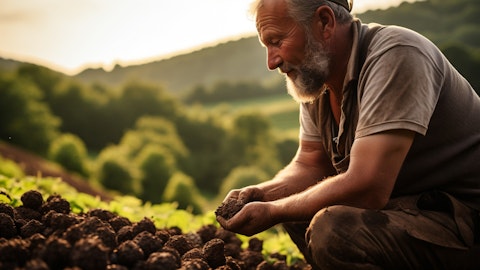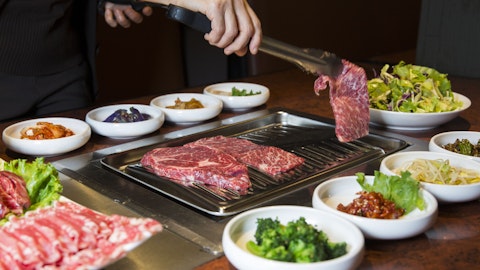And I think the — I think we’re benefiting because we’re gaining, I think, more and more customers. So even though some of our older customers might be down a bit, we’re gaining with more seats in similar areas, and we’re getting that extra volume. So we’re optimistic that it’s going to find the balance. And our job obviously is to have the most compelling proposition for customers to choose us as their distribution partners and give us a large share of that purchase.
Mark Carden: Got it. That’s helpful context. And then how is your Middle East business holding up amid some of the continued turmoil in the region? Has it remained largely immune outside of some sourcing adjustments? Or has it gotten any more challenging?
Chris Pappas: I think the only challenge was business was almost too good coming out of the fourth quarter. I think when — again, when we chose to enter that market, we did a lot of homework, and we thought it was going to become more and more of a chosen destination from European travelers, the world travelers and a lot of the money that’s in the Middle East, and the business continues to perform. I think the only major headwind we had was that big storm. If you followed over the past few weeks, they got hit with torrential downpours that kind of flooded the streets, and we lost a few days of business. But some of the trouble in the Red Sea as far as getting product in was a bit of a headwind, but the business — that management team there is first class. They continue to execute, and we’re excited about the additional building that we’ve been adding on and building to give them more capacity so they can meet the demand that keeps coming.
Operator: Our next question comes from Peter Saleh with BTIG.
Peter Saleh: Congrats on a great start to the year. I didn’t want to ask about the complexion of growth for this year. Your organic growth is a little over 8% here or closer to 9%. I think that’s well above like your long-term algorithm, the 4% to 6% organic growth. So can you just help us out a little bit, how do we think about this year? How sustainable is that organic growth rate? And how do we think about organic versus acquisition benefit for the balance of this year?
Jim Leddy: Thanks for the question, Pete. In terms of acquired growth, the bulk of it has happened this past quarter. So the 2 big acquisitions we did last year were Hardie’s and Greenleaf from a top line perspective. And we bought Hardie’s really right at the end of the first quarter, and we bought Greenleaf in the middle of the second quarter. So it’s really heavily weighted. You see our acquired wrap was 12.7% this quarter, and that will decline significantly. In terms of organic, the mid- to the high point of our guidance implies about kind of in the 6%, maybe 7% organic range for the full year. So it will decline a little bit from the 8%. Now some of that will depend on price, what inflation does, but I think we’re comfortable with the guidance right now and it kind of implies our long-term growth algorithm from an organic perspective.
Peter Saleh: Great. And then can you just comment a little bit on the protein market and what you’re seeing currently? I think last year around this time, maybe spring and into the summer, there was some volatility that happened. What are you seeing currently? What are the expectations, I guess, at least in the medium to near term?
Chris Pappas: Yes. Again, I would say if we were that good at predicting commodity markets, we’d be — we’d own a trading floor somewhere in Bermuda. It’s — so it’s kind of — you would think it’s predictable, Peter, but it’s always proven us that there’s some underlying factors that sometimes confuse the market. The — it’s driven by retail, right? So if retail slows down, especially for what we buy, which is upper choice and a lot of prime, you do get breaks in the prices. I think year-over-year, I think we had a few points of inflation over the last year’s first quarter. But we don’t take major, major positions. We’ve learned that there isn’t a lot of upside unless the prices drop so low that you’re really comfortable to take a much larger position. So I think that we go with the market. If customers want to buy in and have us take a position for them, we’ll do it. But we try to avoid that big risk of being wrong.
Jim Leddy: Pete, I’ll just add that while we had some year-over-year inflation, prices in the protein market in Q1 kind of behaved kind of how they’ve behaved historically. In other words, sequentially coming out of the holiday season in Q4, prices kind of declined as they normally do in Q1. And then you — historically, you would see them start to ramp up as you’re going into barbecue season in the summer. And so that’s still to be determined.
Operator: The next question comes from Andrew Wolf with CL King.
Andrew Wolf: I want to ask also sort of on the organic sales being so much stronger than your competitors and really most of the sector, the restaurants included. How much would you sort of say this is your core customer base is being more well positioned, less sensitive to inflation in their consumer behavior versus just taking share of the business either through better selling or better products and selection, or just more people going up and down the street?
Chris Pappas: Yes. Andy, I think a lot is with taking share. I don’t want to sound like Rodney Dangerfield that we get no respect being the smaller of all the public companies in the space. But we’ve invested a lot, people that really understand our business and follow our story. We’re not a new business. We’re getting close to our 40th anniversary. We know the industry really well. And we’ve made big bets. We’ve invested in facilities. We’re investing in technology, and we’ve made tremendous investments in talent. And no one’s completely immune to economic cycles, but we made the investments to continue to grow and continue to protect our turf. And our turf is really upscale casual to fine dining and to be the best at it. And I think, I hate to have a Cassandra’s crystal ball prediction, but doing this now for almost 40 years, I’ve seen a lot of the cycles.
Yes, we do have a piece of our customer portfolio that they are down. They are seeing negative comps. And we kind of expected that. And we kind of expected that we’ll continue to go out and they do have a lot of choices, and we go after a huge amount of new customers every year to have that diversity of super high-end, high-end, upscale casual and emerging concepts. So we went into produce, I call it, that’s our plant-based hedge. We like the business. We bought Hardie’s last year to get into Texas, a great company [where Chefs’ is sizing] it. Like we said, we’re going to add more and more products and give their sales teams more opportunities, and we call it more at bats with customers with all the Chefs’ products, our over 50,000 items that make us who we are that come from thousands of artisan producers.




